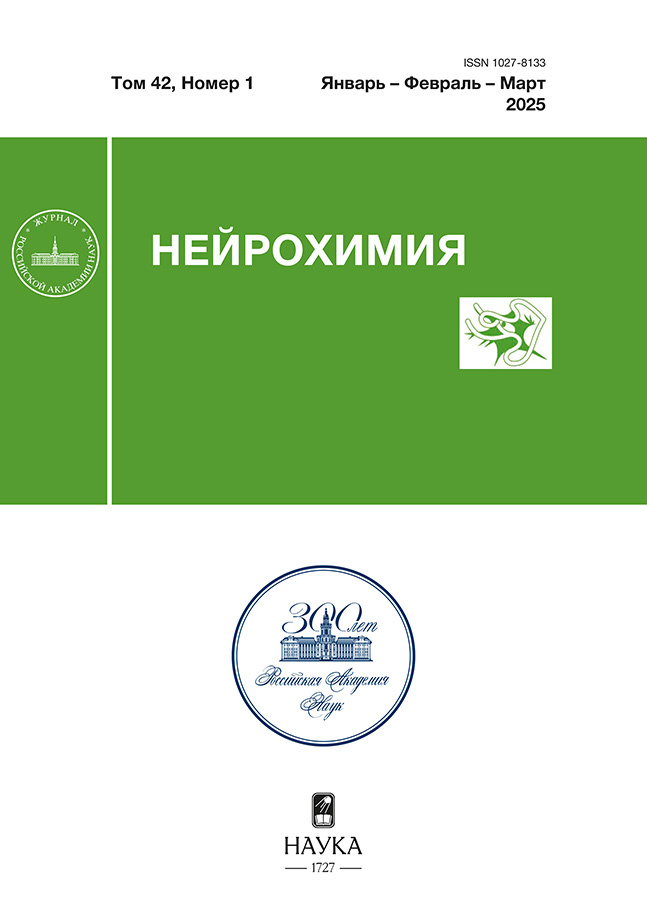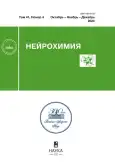Влияние различных видов стресса матери на состояние некоторых компонентов редокс-системы мозга у самцов и самок крыс на 20-й день эмбрионального периода развития
- Авторы: Вьюшина А.В.1, Притворова А.В.1, Пивина С.Г.1, Акулова В.К.1, Ордян Н.Э.1
-
Учреждения:
- Институт физиологии им. И.П. Павлова РАН
- Выпуск: Том 41, № 4 (2024)
- Страницы: 362-371
- Раздел: Статьи
- URL: https://gynecology.orscience.ru/1027-8133/article/view/653878
- DOI: https://doi.org/10.31857/S1027813324040077
- EDN: https://elibrary.ru/EGPUTH
- ID: 653878
Цитировать
Полный текст
Аннотация
Исследовали влияние пренатального стресса, посттравматического стрессового расстройства, а также их сочетанного действия у крыс матерей на состояние гипофиз-адреналовой системы и окислительно-восстановительного баланса мозга у 20-дневных эмбрионов. Пренатальный стресс матерей приводил к повышению уровня кортикостерона в крови и снижению уровня восстановленного глутатиона в мозге у самцов эмбрионов. У самок эмбрионов повышался уровень продуктов Фентон-индуцированной окислительной модификации белков и снижался уровень восстановленного глутатиона в мозге. Моделирование посттравматического стрессового расстройства у матерей приводило к повышению уровня кортикостерона в крови, а также к снижению уровня продуктов Фентон-индуцированной окислительной модификации белков в мозге у самцов эмбрионов. У самок эмбрионов повышались уровни продуктов спонтанной и Фентон-индуцированной окислительных модификаций белков в мозге. Сочетанное действие двух видов стресса у матерей приводило к повышению уровня кортикостерона в крови, снижению уровня продуктов спонтанной и повышению Фентон-индуцированной окислительных модификаций белков, а также к снижению уровня восстановленного глутатиона в мозге у самцов эмбрионов. У самок повышались все исследованные показатели уровня продуктов окислительной модификации белков в мозге. Таким образом все три исследованных вида стресса у матери вызывают изменения в гипоталамо-гипофиз-адреналовой системе и в окислительно-восстановительном балансе мозга у 20-дневных эмбрионов. Эти изменения у самцов и самок эмбрионов различны, и у большинства исследованных показателей паттерн различий инвертирован по отношению к контрольной группе. Подобные трансформации у эмбрионов могут привести к негативным изменениям в нейроэндокринной системе у взрослых потомков стрессированных крыс матерей.
Ключевые слова
Полный текст
Об авторах
А. В. Вьюшина
Институт физиологии им. И.П. Павлова РАН
Email: pritvorovaav@infran.ru
Россия, Санкт-Петербург
А. В. Притворова
Институт физиологии им. И.П. Павлова РАН
Автор, ответственный за переписку.
Email: pritvorovaav@infran.ru
Россия, Санкт-Петербург
С. Г. Пивина
Институт физиологии им. И.П. Павлова РАН
Email: pritvorovaav@infran.ru
Россия, Санкт-Петербург
В. К. Акулова
Институт физиологии им. И.П. Павлова РАН
Email: pritvorovaav@infran.ru
Россия, Санкт-Петербург
Н. Э. Ордян
Институт физиологии им. И.П. Павлова РАН
Email: pritvorovaav@infran.ru
Россия, Санкт-Петербург
Список литературы
- Mattern F., Post A., Solger F., O’Leary A., Slattery D.A., Rief A., Haaf Th. // Behav.Brain Res. 2019. V. 359. № 1. Р. 143–148. doi: 10.1016/j.bbr.2018.10.037.
- Дыгало Н.Н., Науменко Е.В. // Онтогенез. 1984. Т. 15. № 2. С. 215–218.
- Ордян Н.Э., Пивина С.Г. // Рос.Физиол.Журн.им.И.М.Сеченова. 2003. Т. 89. № 1. С. 52–59. doi: 10.1023/b:neab.0000028286.83083.73.
- Krontira A.C., Cruceanu C., Binder E.B. // Trends. Neurosci. 2020. V. 43. № 6. P. 394–405. doi: 10.1016/j.tins.2020.03.008.
- Дыгало Н.Н. // Журн. высш. нерв. Деят. 1999. Т. 49. Вып. 3. С. 489–494.
- Yao S., Lopes-Tello J., Sferruzzi-Perri A.N. // Biology of Reproduction. 2021. V. 104. № 4. Р. 745–770. doi: 10.1093/biolre/ioaa232.
- Signorello M.G., Ravera S., Leoncini G. // Int. J.Mol. Sci. 2024. V. 25. № 7. Р. 1–14. https://doi.org/10.3390/ijms25073776
- Mikhed Y., Gorlach A., Knaus U.S., Daiber A. // Red. Biol. 2015. V. 5. P. 275–289. doi: 10.1016/j.redox.2015.05.008.
- Timme-Laragy A.R., Goldstone J.V., Imhoff B.R., Stegeman J.J., Hahn M.E., Hansen J.M. // Free rad. Biol. Med. 2013. V. 61. P. 1–30. doi: 10.1016/j.freeradbiomed.2013.06.011.
- Thompson L.P., Al-Hasan Y. // J. Pregnancy. 2012. V. 2012. P.1–8. doi: 10.1155/2012/582748.
- Schieber M., Chandel N.C. // Curr. Biol. V. 24. № 10. P. 453–462. doi: 10.1016/j.cub.2014.03.034.
- Лущак В.И. // Биохимия. 2007. Т. 72. № 8. С. 995–1016.
- Cao-Lei L., Rooij S.R., King S., Matthews S.G., Metz G.A.S., Roseboom T.J., Szyf M. // Neurosci. Biobehav. 2020. V. 117. P. 198–210. doi: 10.1016/j.neubiorev.2017.05.016.
- Кулинский В.И., Колесниченко Л.С. // Биомедицинская химия. 2010. Т. 56. № 6. С. 675–662. doi: 10.18097/PBMC20105606657.
- Hansen J.M., Harris C. // Biochim. Biophys. Acta. 2015. V. 1850. № 8. P. 1527–42. doi: 10.1016/j.bbagen.2014.12.001.
- Huerta-Cervantes M., Peña-Montes D.J., López-Vázquez M.A., Montoya-Pérez R., Cortés-Rojo C., Olvera-Cortés M.E., Saavedra-Molina A. Nutrients. 2021. V. 13. № 5. P. 1–15. doi: 10.3390/nu13051575.
- Karanikas E., Daskalakis N.P., Agorastos A. // Brain Sci. 2021. V. 11. № 6. Р. 1–28. doi: 10.3390/brainsci11060723.
- Zhang X.G., Zhang H., Liang X.L., Liu Q., Wang H.Y., Cao B., Cao J., Liu S., Long Y.J., Xie W.Y., Peng D.Z. // Genet. Mol. Res. 2016. V. 15. № 3. P. 1–17. doi: 10.4238/gmr.15039009.
- Chagas L.A., Batista T.H., Ribeiro A.C.A.F., Ferrari M.S., Vieira J.S., Rojas V.C.T., Kalil-Cutti B., Elias L.L.K., Giusti-Paiva A., Vilela F.C. // Behav. Brain Res. 2021. V. 399. P. 1–9. doi: 10.1016/j.bbr.2020.113026.
- Кострова Т.А. Биохимические и поведенческие показатели в отдаленный период после острых отравлений нейротоксикантами и их фармакологическая коррекция. Дисс… канд. мед. Наук. СПб: Институт токсикологии ФМБА, 2019. 188 с.
- Ордян Н.Э., Смоленский И.В., Пивина С.Г., Акулова В.К. // Журн. высш. нервн. деят. 2013. Т. 63. № 2. С. 280–289. doi: 10.7868/S0044467713020068.
- Арутюнян А.В., Дубинина Е.Е., Зыбина Н.Н. Методы оценки свободнорадикального окисления и антиоксидантной системы организма. СПб: ИКФ “Фолиант”. 2000. 104 с.
- Кузьменко Д.И., Лаптев Б.И. // Вопр. мед. химии. 1999. Т. 45. № 1. С. 47–54. PMID: 10205828.
- Назаров И.Н., Казицина Л.А., Зарецкая И.И. // Журн. общ. химии. 1956. Т. 27. № 3. С. 606–623.
- Lovlin V.N., Vinichenko E.L., Sevostianov I.A. // The Journal of scientific articles “Health and Education Millennium”. 2017. V. 19. № 7. Р.113–115.
- Yehuda R., Bierer L.M. // Prog. Brain Res. 2008. V. 167. P. 121–135. doi: 10.1016/S0079-6123(07)67009-5.
- Ордян Н.Э., Пивина С.Г., Миронова В.И., Ракицкая В.В., Акулова В.К. // Росс. Физиол. Журн. им. И.М. Сеченова. 2014. Т. 100. № 12. С. 1409–1420.
- Louvart H., Maccari S., Vaiva G., Darnaudery M. // Psychoneuroendocrinology. 2009. V. 34. P. 786–790. doi: 10.1016/j.psyneuen.2008.12.002.
- Sze Y., Brunton P.J. // Eur. J. Neuroscience. 2019. V. 52. P. 2487–2515. doi: 10.1111/ejn.14615.
- Soares-Cunha C., Coimbra B., Borges S., Domingues A.V., Silva D., Sousa N., Rodrigues A.J. // Front. Behav. Neurosci. 2018. V. 12. P. 1–15. doi: 10.3389/fnbeh.2018.00129.
- Отеллин В.А., Хожай Л.И., Ордян Н.Э. // Пренатальные стрессорные воздействия и развивающийся головной мозг. СПб.: “Десятка”, 2007. 240 с.
- Вьюшина А.В., Притворова А.В., Флеров М.А. // Нейрохимия. 2012. Т. 29. № 3. С. 240–246.
- Reed E.C., Case A.J. // Front. Physiol. 2023. P. 1–13. doi: 10.3389/fphys.2023.1130861.
- Mora S., Dussaubat N., Diaz-Veliz G. // Psychoneuroendocrinology. 1996. V. 21. № 7. P. 609–620. doi: 10.1016/s0306-4530(96)00015-7.
- Aiken C.E., Tarry-Adkins J.L., Spiroski A., Nuzzo A.M., Ashmore T.J., Rolfo A., Sutherland M.J., Camm E.J., Giussani D.A., Ozanne S.E. // The FASEB Journ. 2019. V. 33. № 6. Р. 7758–7766. doi: 10.1096/fj.201802772R.
Дополнительные файлы















